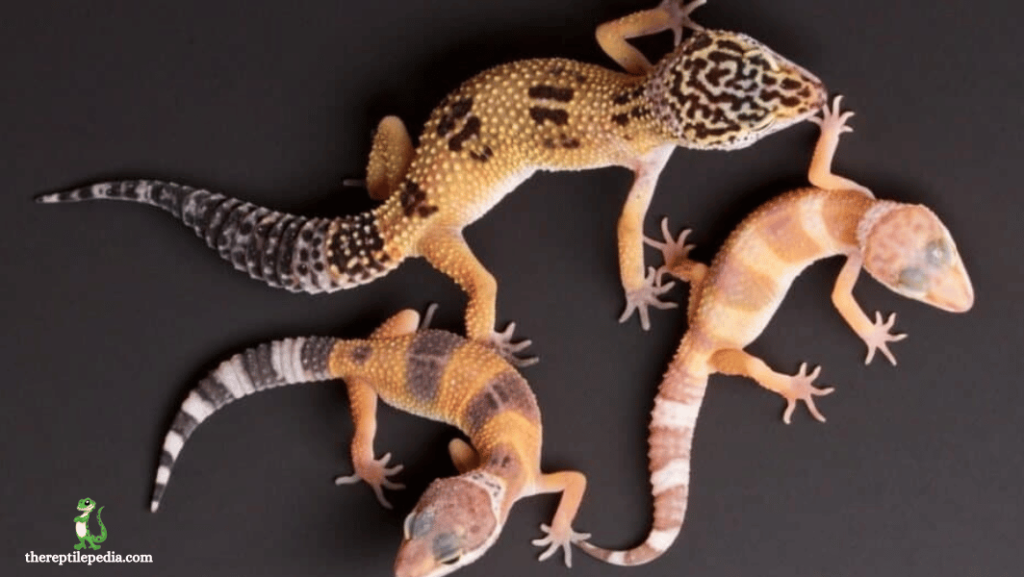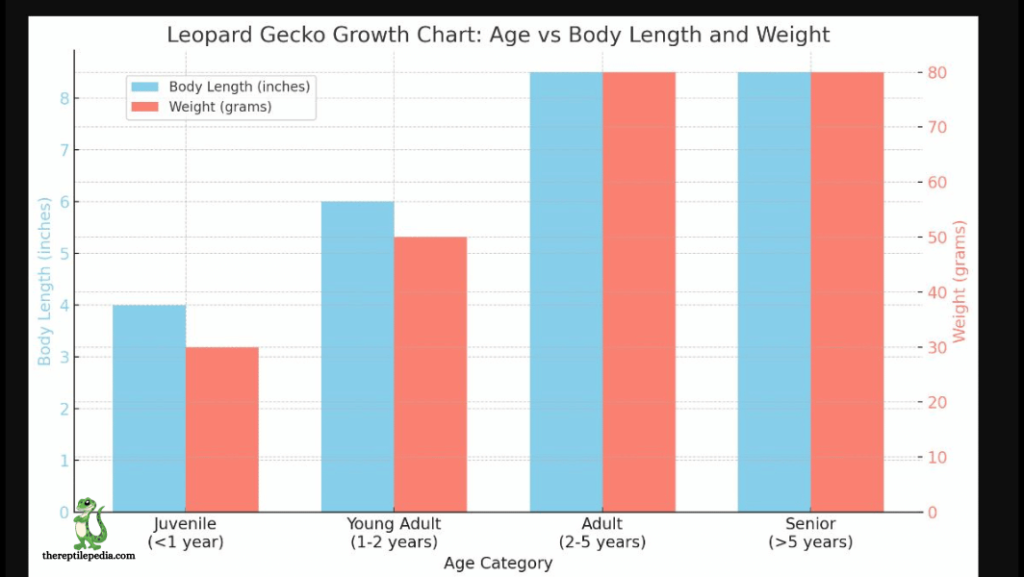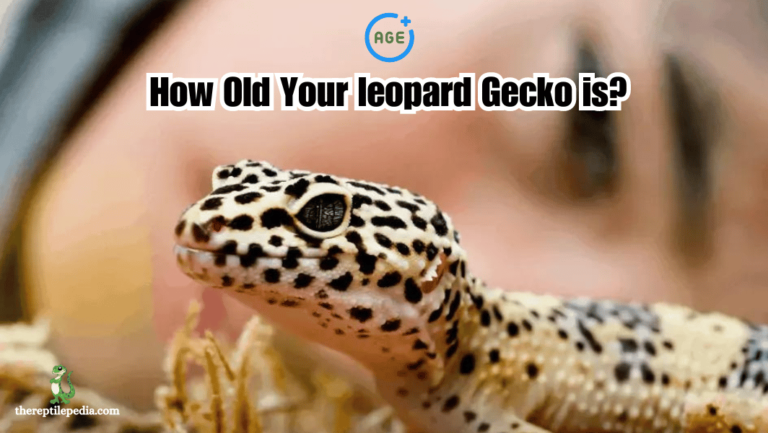Determining the age of my leopard gecko can seem challenging, but it’s not impossible. While measuring the weight and length can give a general age idea, it’s not always precisely accurate. Fortunately, if you’re unsure about your pet’s exact age, getting the birth date from the breeder can be a reliable method. When I first got my new leopard gecko, I was keen to know how old it was. Despite the question How Old Your leopard Gecko is, I discovered that there are ways to get a good idea of their age. Still, always remember that each gecko is unique, and these methods are just starting points to understanding your pet better.
Table of Contents
Average Lifespan Of A Leopard Gecko
When trying to get an idea of your pet’s age, it’s insightful to look closely at its tail. When they are younger, a leopard gecko’s tail is typically thick and long, indicating a young individual still growing. As they grow older, the tail often shrinks and becomes thinner. A fully grown leopard gecko, which can live anywhere from 10 to 20 years, and in some cases, has even lived up to 25 years, will have a tail that is proportional in size, appearing longer and thicker. This subtle change in tail size and thickness can provide a rough estimate of age, as a younger gecko needs more resources to grow, reflected in a fuller tail.
4 Ways To Tell How Old Your Leopard Gecko Is

Discovering the age of your leopard gecko can be a fascinating journey, and there are several methods to unlock this mystery.
1. Gauging Age Through Height
To learn about your leopard gecko’s age, one approach is to measure its height. By consulting a Leopard gecko size chart, you can find their approximate age. However, it’s important to know that this method only offers insights into the pet’s age until it’s 18 months old. Once your leopard gecko has grown into an adult, height becomes a less reliable indicator of age. This is because, beyond 18 months, growth in height plateaus, and further changes in size are not significant enough to gauge age accurately.
| Age (Months) | Males (cm) | Females (cm) |
| 1-2 | 8 | 7.5 |
| 3-4 | 10 | 9.5 |
| 5-6 | 12 | 11.5 |
| 7-8 | 14 | 13.0 |
| 9-10 | 16 | 14.5 |
| 11-12 | 17 | 15.5 |
| 13-14 | 18 | 16.5 |
| 15-16 | 19 | 17.5 |
| 17-18 | 20 | 18.0 |
While height can give you a general idea about the age during the early stages of your leopard gecko’s life, other factors like size, growth rate, and physical features become more relevant as they mature. Observing changes at the tip of the nose to the base of the tail can also offer clues, but these are subject to generalization and may vary from one gecko to another. For a more accurate understanding of your pet’s actual age, especially after it has reached adulthood, considering behavioral indicators and consulting with a vet or the breeder from whom the gecko was purchased can provide more definitive answers.
2. Leopard Gecko Weight
Measuring the weight of your leopard gecko can offer a guess at its age, but it’s crucial to acknowledge the limitations of this procedure. Weight can be a less reliable indicator for age as it’s prone to change due to various factors such as illnesses, condition, overfeeding, and even natural processes like pregnancy in females. For instance, a young gecko might gain weight rapidly, which could be misleading.
| Age (Months) | Males (g) | Females (g) |
| 1-2 | 3 | 2.5 |
| 3-4 | 8 | 7.0 |
| 5-6 | 15 | 14.0 |
| 7-8 | 25 | 22.0 |
| 9-10 | 35 | 30.0 |
| 11-12 | 45 | 40.0 |
| 13-14 | 55 | 50.0 |
| 15-16 | 60 | 55.0 |
| 17-18 | 65 | 60.0 |
| 19-24 | 70 | 65.0 |
As they mature into adulthood, weight variations become less indicative of age, especially since an adult leopard gecko’s weight stabilizes unless affected by health issues. Therefore, while weight can give a rough idea, it’s not always legible to tell the exact age, particularly when the pet suffers from any condition or is beyond the young phase where growth is most apparent.
ALSO READ: Why Leopard Geckos Chirp?
3. Colors And Patterns
The colors and patterns on a leopard gecko can provide a hint about its age. Observing the patterns on these geckos reveals that adults often display spotted bands rather than full bands across their body, indicating a transition from youth to adulthood. If your gecko lacks spots, it’s likely under a year old.
Moreover, the type of coloration is also affected by age; they tend to have a rich and bright form of their normal coloration at birth, which gradually becomes muted as they age. This mellowing of colors continues throughout their life, with standard leopard geckos often adding more yellow to their palette as they age. However, it’s important to note that this is not guaranteed with all morphs, as typical patterns may vary.

4. Shedding Patterns
A last way to tell the age of your leopard gecko is by observing how often they shed their skin. Young geckos, which are growing rapidly and need more space, tend to shed every one to two weeks due to their fast growth rates. This lot of shedding is a clear indicator of youth. In contrast, an adult leopard gecko will shed less frequently, about every four to eight weeks, as their growth has plateaued and not much change is involved in their size. This shift in shedding frequency can provide valuable clues about whether your gecko is still in its growth phase or has reached maturity.
A Leopard Gecko Growth Journey to Full Size
A leopard gecko typically reaches its full size within 18 months, although growth can somewhat continue throughout the rest of its life. This later growth, however, doesn’t affect their size significantly.
It’s interesting to note that sexual maturity is achieved earlier, with males potentially reaching it as young as ten months old, while females usually take about a year. While it’s possible to encourage faster growth through environmental factors such as maintaining a consistently higher temperature of 90° degrees Fahrenheit (32° C) and ensuring higher humidity, these conditions don’t necessarily mean the gecko is healthier.
Understanding these growth phases provides insights into the age and development stage of your leopard gecko.
ALSO READ: Leopard Gecko Pale And White?
How Do You Know If A Leopard Gecko Is A Boy Or Girl?
Determining the sex of a leopard gecko is a straightforward process, primarily hinging on physical characteristics that become evident as the gecko matures. Typically, the differences between male and female leopard geckos start to become noticeable when they reach about 6 months of age. For those keen on identifying the sex of their pet, the key is to look for the presence of preanal pores and hemipenal bulges. Males boast a distinct V-shaped row of preanal pores above their vent, which secretes a waxy substance, and exhibit noticeable hemipenal bulges at the base of their tail, indicative of their reproductive organs.
On the other hand, female leopard geckos have a less pronounced or entirely absent row of preanal pores and lack the hemipenal bulges, presenting a more streamlined silhouette towards the tail base. Additionally, males typically have thicker, broader heads and necks compared to their female counterparts, adding another layer of distinction. Observing these physical traits requires a gentle handling approach, ensuring the gecko’s comfort and safety during examination. With a bit of practice and careful observation, leopard gecko enthusiasts can confidently discern the sex of their beloved reptiles, aiding in proper care and breeding practices.
Conclusion
In Conclusion, Leopard geckos are considered fully grown by 18 months old, but pinpointing the exact age of your pet can be a blend of science and speculation. Making an approximate guess about your pet’s age involves measuring both height and weight, and cross-referencing these with charts for a good idea. However, the best way to truly know the age of your leopard gecko is by obtaining the birth details directly from the breeder. This direct approach eliminates much of the guesswork and provides a solid foundation for understanding the life stage and care needs of your reptilian companion.
FAQs:
-
How big is a 6 month old leopard gecko?
A 6-month-old leopard gecko typically measures between 4 to 6 inches in length from snout to tail tip. At this age, they are rapidly growing and transitioning from their juvenile phase towards adolescence. Proper nutrition and habitat conditions play a crucial role in reaching this size, ensuring a healthy growth trajectory for these fascinating reptiles.
-
How do you know when your leopard gecko is getting old?
Recognizing an aging leopard gecko involves observing signs like a slowdown in activity, reduced appetite, and possible changes in skin texture or coloration. Older geckos may also shed less frequently and show more pronounced signs of wear, such as nicks or scars. Regular monitoring and adapting their care can ensure your senior gecko maintains a good quality of life in its golden years.

